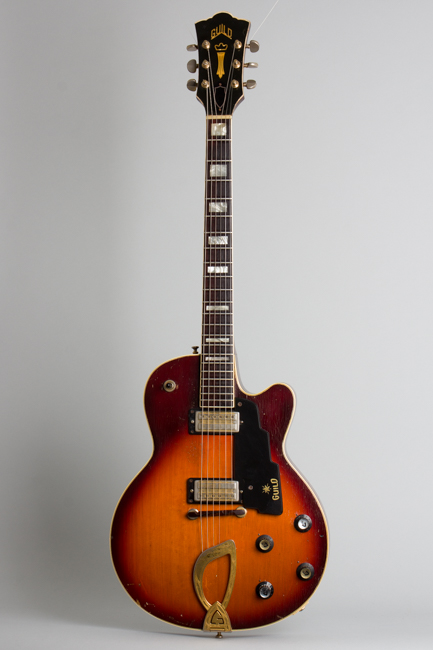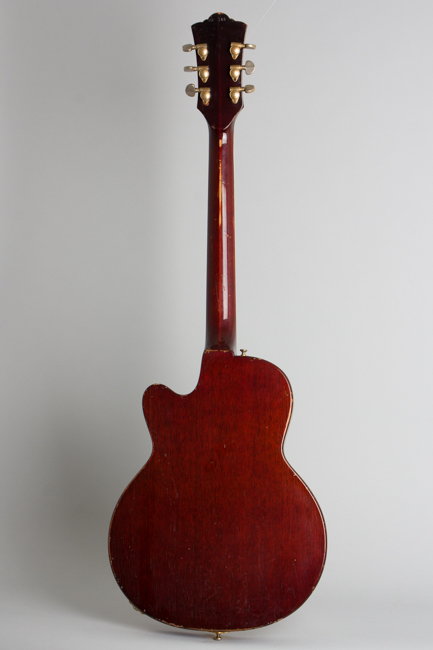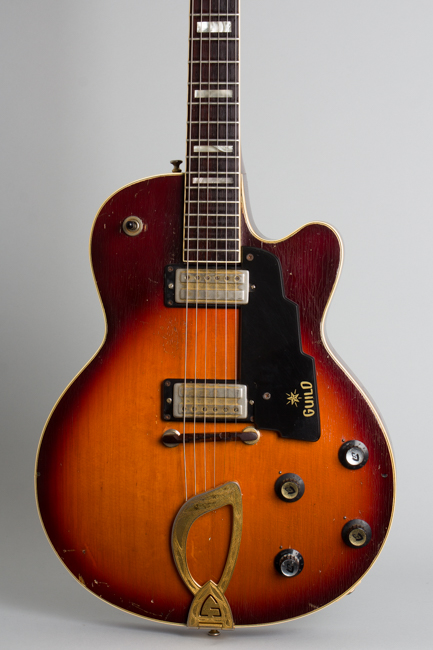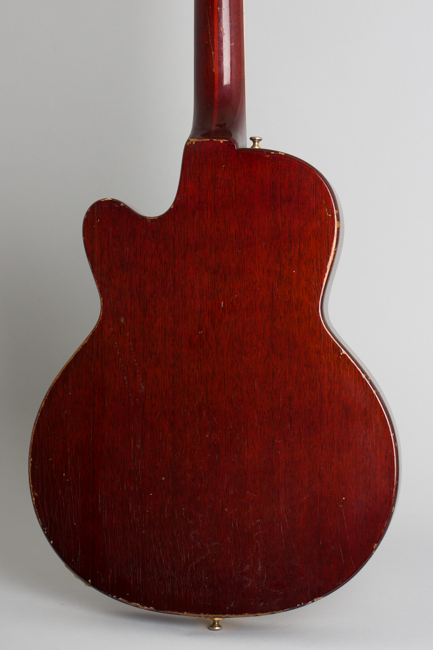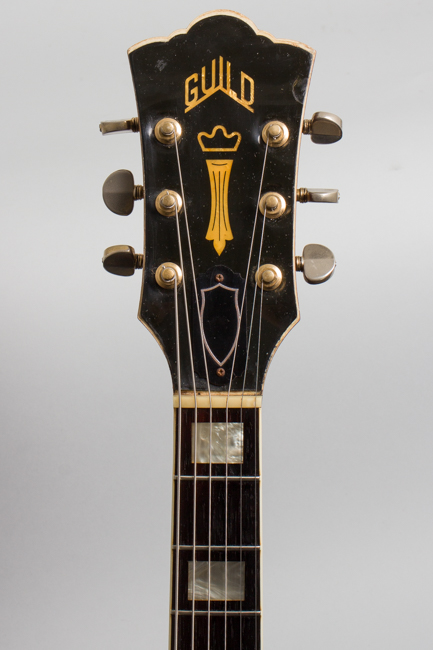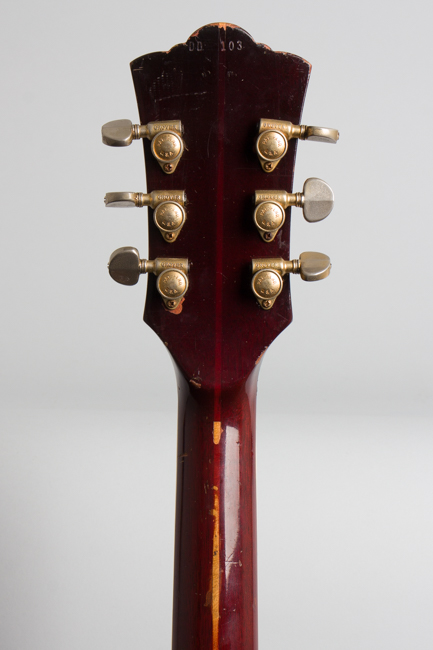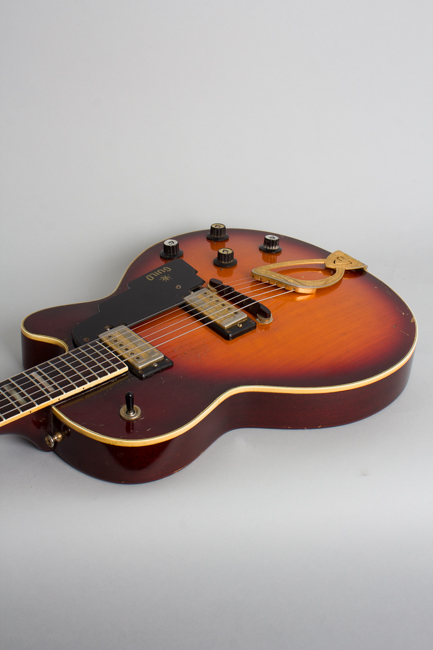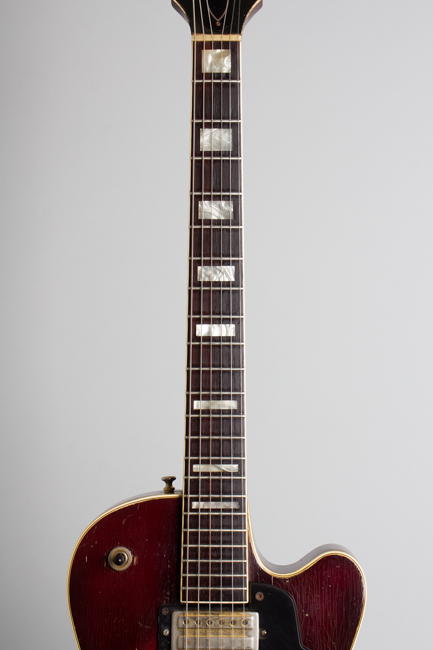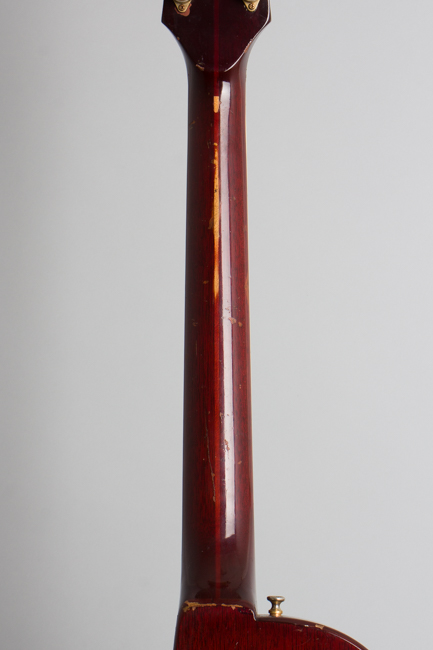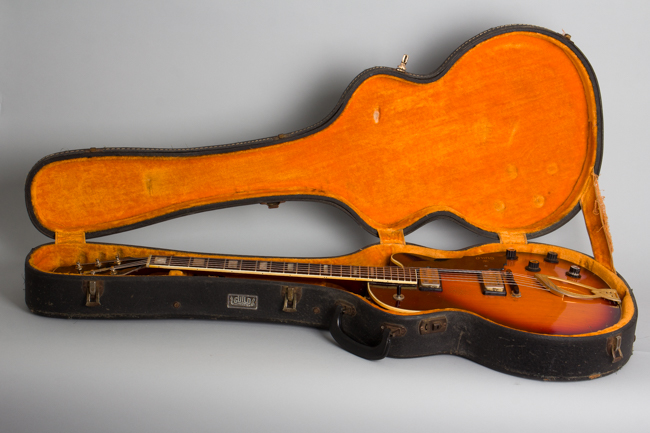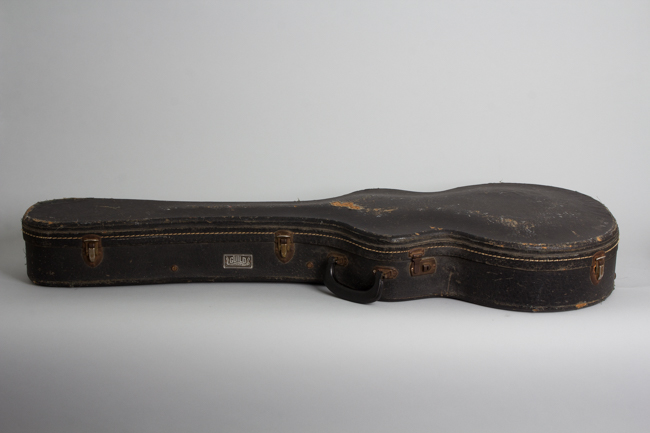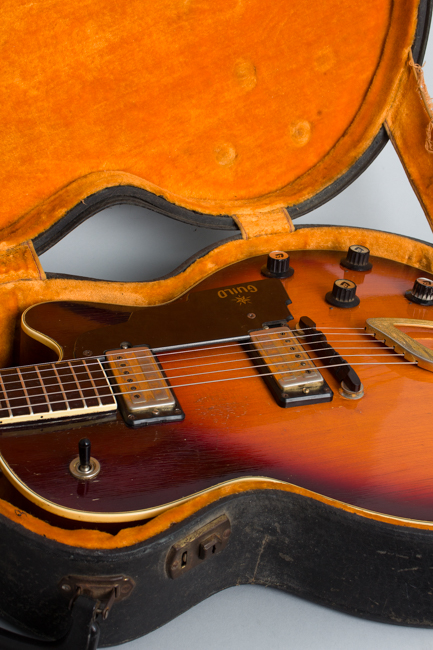Guild M-75 BluesBird Thinline Hollow Body Electric Guitar (1967)
This item is currently on hold.
Item # 11194
Prices subject to change without notice.
Guild M-75 BluesBird Model Thinline Hollow Body Electric Guitar (1967), made in Hoboken, NJ, serial # DD-103, sunburst top, dark back and sides finish, laminated mahogany body and neck, spruce top, rosewood fingerboard, original black hard shell case.
This well-played but striking guitar is one of the VERY first re-issue Guild M-75 BlueBirds from late 1967. The serial number DD-103 is actually only the third of this series! These early re-issue models were actually very similar to the original 1950's M-75s, distinguished mostly by having 1960's Guild humbucking pickups instead of Franz single coils. The cosmetics were also updated a bit with '67-style headstock and pickguard stylings, and the tuners were now stock Grover Rotomatics. This made for a fairly upscale model at the time.
Guild had discontinued the unique small hollow-body M-75 in the early '60's, an unfortunate decision in retrospect as the design is one of the company's most distinctive instruments. While sales must have lagged early in the decade by the mid-60's Guild apparently noticed a renewed demand for the model thus triggering this 1967 re-appearance. Company lore states that blues players especially in the Boston area had latched onto the older M-75, prompting the name to be switched from the generic "Aristocrat" to the more colorful "BlueBird" when the updated model was formally re-introduced.
Through the late '60s the "new" M-75 underwent a fairly rapid evolution, eventually turning by the 1970's into a solid body guitar more like a Les Paul. This earliest model is a fully hollow, small body with a laminated spruce top, still built from the original '50's patterns. Only 38 of these shipped in 1967, and less than 300 in the entire late '60s.
Despite its small size this is quite a deluxe little guitar with a multibound top, block fingerboard inlay and gold plated hardware including an engraved tailpiece. It is very resonant, a super light and handy player with a lively sound. This is one of the rarer and cooler mid/late '60's Guilds, the earliest example of these we have ever seen and a very unique sounding guitar in any era.
Overall length is 39 1/2 in. (100.3 cm.), 13 5/8 in. (34.6 cm.) wide at lower bout, and 2 1/8 in. (5.4 cm.) in depth, measured at side of rim. Scale length is 24 1/2 in. (622 mm.). Width of nut is 1 5/8 in. (41 mm.).
This is a fairly well-used guitar but largely original, structurally fine and not TOO heavily worn despite decades of use. The finish has a decent amount of general wear including a large collection of dings, dents and scratches overall but no really large areas of loss. There are some pick marks to the top between the pickups and rubbing down to the wood on the bottom back edge. The back of the neck is down to the wood along some of the spine, with some dings and dents and a long scratch behind the 7-10th fret area that looks like a crack but is not. There are a couple of laminate checks to the back, visible but again only superficially into the wood. The plastic headstock veneer has shrunken up a decent amount and is a bit puckered around the tuners.
The external hardware remains original except for two of the knobs; all are correct Guild pieces but two are gold-capped, and the other two silver. The often missing original wooden bridge and adjustable mounting cups are intact, lowered a bit from beneath long ago to achieve a better action. The pickups and tuners have some fairly heavy wear to the gold plating, as does the upper edge of the tailpiece.
There is a receipt in the case indicating the guitar was re-wired in 1989 with new pots and switch; that switch is more Rickenbacker styled than Guild with a long black plastic tip. As a result of this work (we presume) the selector switch works as expected but the controls are reversed; the upper set of knobs acts on the treble pickup, while the lower set affects the neck unit. We can only assume this was the way the owner wanted it! A Les Paul style jackplate has been added to the side.
The frets appear original; it is possible the lower position frets were replaced long ago but they are consistent with the rest; as it stands these have been crowned down a bit with little subsequent wear. The fingerboard has a bit of older wear into the rosewood. We were told this was a one-owner guitar for most of the 55 years until recent times. While well-used over the decades this remains an excellent player with quite a low action for one of these, a light, handy and super friendly little guitar with a great sound. It lives in its rare and solid if somewhat worn OHSC. Overall Very Good + Condition.
This well-played but striking guitar is one of the VERY first re-issue Guild M-75 BlueBirds from late 1967. The serial number DD-103 is actually only the third of this series! These early re-issue models were actually very similar to the original 1950's M-75s, distinguished mostly by having 1960's Guild humbucking pickups instead of Franz single coils. The cosmetics were also updated a bit with '67-style headstock and pickguard stylings, and the tuners were now stock Grover Rotomatics. This made for a fairly upscale model at the time.
Guild had discontinued the unique small hollow-body M-75 in the early '60's, an unfortunate decision in retrospect as the design is one of the company's most distinctive instruments. While sales must have lagged early in the decade by the mid-60's Guild apparently noticed a renewed demand for the model thus triggering this 1967 re-appearance. Company lore states that blues players especially in the Boston area had latched onto the older M-75, prompting the name to be switched from the generic "Aristocrat" to the more colorful "BlueBird" when the updated model was formally re-introduced.
Through the late '60s the "new" M-75 underwent a fairly rapid evolution, eventually turning by the 1970's into a solid body guitar more like a Les Paul. This earliest model is a fully hollow, small body with a laminated spruce top, still built from the original '50's patterns. Only 38 of these shipped in 1967, and less than 300 in the entire late '60s.
Despite its small size this is quite a deluxe little guitar with a multibound top, block fingerboard inlay and gold plated hardware including an engraved tailpiece. It is very resonant, a super light and handy player with a lively sound. This is one of the rarer and cooler mid/late '60's Guilds, the earliest example of these we have ever seen and a very unique sounding guitar in any era.
Overall length is 39 1/2 in. (100.3 cm.), 13 5/8 in. (34.6 cm.) wide at lower bout, and 2 1/8 in. (5.4 cm.) in depth, measured at side of rim. Scale length is 24 1/2 in. (622 mm.). Width of nut is 1 5/8 in. (41 mm.).
This is a fairly well-used guitar but largely original, structurally fine and not TOO heavily worn despite decades of use. The finish has a decent amount of general wear including a large collection of dings, dents and scratches overall but no really large areas of loss. There are some pick marks to the top between the pickups and rubbing down to the wood on the bottom back edge. The back of the neck is down to the wood along some of the spine, with some dings and dents and a long scratch behind the 7-10th fret area that looks like a crack but is not. There are a couple of laminate checks to the back, visible but again only superficially into the wood. The plastic headstock veneer has shrunken up a decent amount and is a bit puckered around the tuners.
The external hardware remains original except for two of the knobs; all are correct Guild pieces but two are gold-capped, and the other two silver. The often missing original wooden bridge and adjustable mounting cups are intact, lowered a bit from beneath long ago to achieve a better action. The pickups and tuners have some fairly heavy wear to the gold plating, as does the upper edge of the tailpiece.
There is a receipt in the case indicating the guitar was re-wired in 1989 with new pots and switch; that switch is more Rickenbacker styled than Guild with a long black plastic tip. As a result of this work (we presume) the selector switch works as expected but the controls are reversed; the upper set of knobs acts on the treble pickup, while the lower set affects the neck unit. We can only assume this was the way the owner wanted it! A Les Paul style jackplate has been added to the side.
The frets appear original; it is possible the lower position frets were replaced long ago but they are consistent with the rest; as it stands these have been crowned down a bit with little subsequent wear. The fingerboard has a bit of older wear into the rosewood. We were told this was a one-owner guitar for most of the 55 years until recent times. While well-used over the decades this remains an excellent player with quite a low action for one of these, a light, handy and super friendly little guitar with a great sound. It lives in its rare and solid if somewhat worn OHSC. Overall Very Good + Condition.
